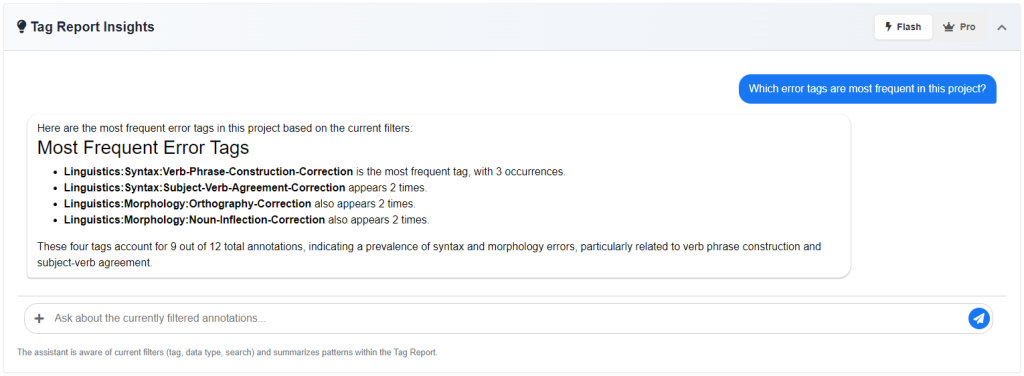The AI Chat is a context-aware research assistant embedded directly in Error Analyzer. More than a conversational partner, it is designed to help you both explore your data and act on it. Its strength lies in adaptability: the chat shifts roles depending on the stage of analysis, offering precise support for sentence-level work and broad synthesis at the project level. In practice, it operates as two complementary tools—the microscope for detailed analysis and annotation, and the telescope for pattern discovery and contextualization.
The Microscope: Pair-Level Analysis #
In the main analysis view, the AI Chat functions as a microscope focused exclusively on the text pair currently under examination. Its knowledge is limited to the original and corrected versions you are working with, making it a precise assistant for micro-level analysis.

Key capabilities include:
- Deep-dive inquiry: You can ask fine-grained linguistic questions, such as “What is the grammatical function of the word running in the corrected text?” or “Identify the dependent clauses in the original sentence.” The chat supports exploratory analysis and clarifies structural or functional elements that might otherwise be overlooked.
- The Auto-Tag Tool: Beyond answering questions, the AI can act directly on your insights. After a discussion, you may issue a command like “Auto-tag this pair based on our conversation.” The AI then applies the appropriate tags programmatically, converting interpretive conclusions into concrete annotations. This feature speeds up the tagging process and reduces repetitive manual work.
In this role, the AI Chat becomes a micro-level research assistant, helping you move seamlessly from reflection to action on a single sentence or text pair.
The Telescope: Project-Level Analysis #
In the Tag Report view, the AI Chat broadens its scope to include your entire dataset and all annotations within the project. It acts as a telescope, enabling macro-level exploration and synthesis.

Key capabilities include:
- Discovering trends and patterns: The chat responds to “big picture” questions such as “Which error tags are most frequent in this project?” or “Show me all examples tagged with subject–verb agreement.” This makes it easier to uncover overarching tendencies in your data.
- Synthesizing information: The AI can summarize and structure information across the corpus, generating outputs like “Summarize the main categories of errors found in this project” or “Generate a table of tag frequencies.” These functions support abstracts, reports, and publications.
- Integrated Web Search: When enabled, the chat extends beyond your dataset by consulting external resources. You might ask, “Compare the error patterns in my data to standard models of second language acquisition.” The system performs a live search and integrates relevant findings from academic literature or linguistic resources, situating your results in a broader research context.
A Seamless Analytical Companion #
Together, these two modes make the AI Chat a flexible assistant that scales with your research needs. The microscope deepens understanding of specific text pairs, while the telescope allows you to synthesize findings and connect them to larger theoretical or pedagogical frameworks. By combining micro-level precision with macro-level discovery, the AI Chat supports researchers in producing analyses that are systematic, efficient, and intellectually grounded.